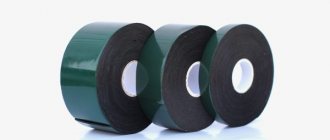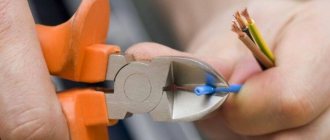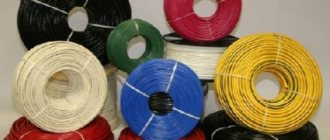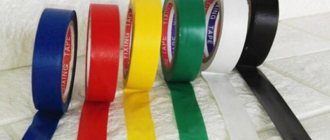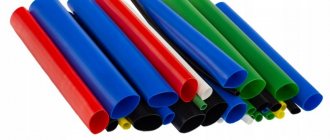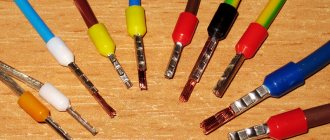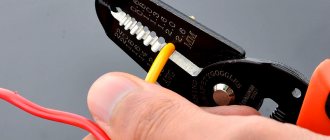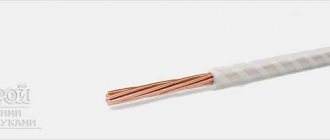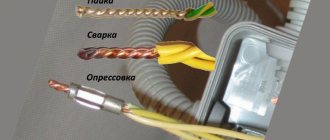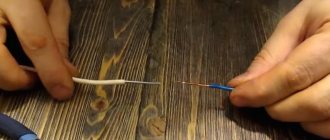Cable and wire products are widely used to transmit electrical energy over a distance. But to ensure good contact, the wires must be securely connected. Let's look at the existing types of wire connections and the order in which they are made.
Connection methods may vary depending on the following factors:
- types of connected cables;
- characteristics of the electric current of the line;
- design features of the equipment in which the wire is used;
- operating conditions of the connection and other points.
Let's consider possible connection methods to ensure the necessary contact.
Twist
One of the simplest ways. In previous years, it was widely used for electrical wiring in apartments and residential buildings. But now, according to PUE standards, it is necessary to use soldering, welding or pressing.
- The insulating coating is removed and about 5 mm of wire is carefully stripped from each end. If the core cross-section is more than 2.5 sq. mm, the length of the cleaned area is increased accordingly,
- the stripped conductors are placed parallel, aligning the ends, and twisted tightly, grasping with pliers,
- the resulting twist is soldered or welded.
An alternative method, when it is important to maintain the length of the wire, involves the opposing arrangement of the wires, crossing them and twisting them by hand. Next, the density is increased using pliers.
Twisting must be performed when connecting conductors of the same metal. Otherwise, the contact will be uneven and will oxidize over time.
Soldering
It is highly reliable. It is possible to solder parallel or twisted wires. But in the first case, it is difficult to ensure high reliability due to the softness of the solder and the difficulty of fixing the wires.
When the soldering has cooled, the contact is insulated with electrical tape or heat shrink.
Brewing
Allows you to significantly increase the reliability of conventional twisting. Performed using a graphite electrode or a gas torch. Considering the complexity of performing work using gas and oxygen cylinders, let’s consider an example of obtaining a connection by electric welding:
What kind of lighting do you prefer?
Built-in Chandelier
- strands up to 100 mm long are twisted, with the overall contact dimensions being half that size,
- ends are trimmed,
- a negative contact is connected next to the insulation with a powerful clamp,
- current mode is set,
- the ends are welded. The duration of the operation is no more than 2 seconds. If necessary, welding is repeated until a smooth ball is obtained at the end of the joint.
It is recommended to use an inverter device that provides the ability to regulate the current. As a last resort, you can use a unit with power characteristics of at least 0.6 kW and voltage up to 24 V.
Expert opinion
It-Technology, Electrical power and electronics specialist
Ask questions to the “Specialist for modernization of energy generation systems”
How to properly twist the wires together in a junction box, car PPE, also called insulating caps, is a polymer tube, plugged at one end and equipped inside with a steel conical spring made of square wire. Ask, I'm in touch!
How to properly connect wires in a car
It is necessary to connect the wires in the car in case of repair (if there was a break), or when installing additional electrical equipment. We'll figure out how to properly connect wiring without a special tool with your own hands, how to make a branch from a wire, and also what methods should be avoided.
Several reliable ways to twist two wires
:
1.
Both wires are stripped to about 1-2 cm. We cross the wires at the place where the insulation ends. You need to twist it as tightly as possible to make good contact. Next we wrap the twisted end around one of the wires.
2.
We unravel the strands of the connected wires into two bundles each. We twist them in pairs, and then twist them together and bend them to the wire.
How to make a branch from a wire.
Using a knife, we strip 1-2 cm of the wire from which we need to make a branch. We also strip the wire that needs to be connected. Next, in the wire from which we are making a branch, we divide the wires into 2 pairs, making an eyelet into which we thread the connected wire. And then we do the twist.
Is it possible to solder?
When repairing electrical wiring, do not use soldering. This is stated in the VAG car repair manual:
How do you connect the wires in your car?
Key words: universal article
Source
How to make parallel twist
To begin, use pliers to pinch the insulation side with a slight release. At the other end, you can twist the wires a little for convenience, gathering them into a bundle. And start twisting with the second pliers.
It is very important that the turns lie evenly and pull the pliers away from you to the side. Otherwise, individual loose turns may appear. In the photo I am doing a triple twist, because it will take a lot of effort to do it well.
10-15 turns are left to minimize contact resistance and increase the contact area. The tip at which the twisting was carried out is bitten off with side cutters. All is ready.
If you are doing this for the first time, I advise you to practice making them on the same small pieces from leftovers before finishing work. During repairs, there may be a lot left over after assembling the shield.
How it shouldn't be
The photo above specifically shows examples of bad twists that can result from the lack of experience or laziness of the installer. From the 1st photo everything is clear: the coils have come out, they are tightened very loosely. You can even push it apart with your fingers
With the second, not everything is so simple; some people leave it like this. But pay attention to the photo above, where there was a triple twist. On a double without options, the turns should fit very tightly to each other. And if the last curved turns are cut off, then the number of turns will not be enough for a full contact connection.
Expert opinion
It-Technology, Electrical power and electronics specialist
Ask questions to the “Specialist for modernization of energy generation systems”
Twisting wires - 105 photos of safe and reliable options It is better to observe how the electrical network works for several hours, after which it is recommended to check the temperature at the attachment point. Ask, I'm in touch!
Pros and cons of twisting wires in a car
The easiest way to connect the wires is by twisting them. It's quick and doesn't require any tools other than a knife to strip the insulation layer. If necessary, twisted contacts are very easily broken without any tools.
The disadvantage of twisting is low reliability, as well as possible contact failure. This method increases the risk of oxidation, which can lead to unstable operation of the powered consumer.
Twisting in automotive electrics is not recommended for use in high current circuits. For example, to power headlights or connect fog lights. But it is quite suitable for low-current circuits. LED lighting may well consist of twisted connections.
A reliable twist is made by intertwining the fluffy ends into one whole. This ensures good contact between the two conductors.
Stranding of stranded conductors
Stranded strand (sometimes mistakenly called stranded) is made up of several thin wires, which gives it flexibility. These wires are used to make power cords, portable sockets and extension cords.
They are also used in distribution boards, where, due to the close proximity of devices and tight spaces, the cable has to be bent strongly. Due to their flexibility, twisting stranded wires using any of the methods described above does not provide high-quality and durable contact.
- each core is dissolved into two or more bundles (depending on the number of wires);
- apply the wires one to the other and twist bundles from different wires in pairs;
- the resulting bundles are twisted into one.
Useful tips Connection diagrams Principles of operation of devices Main concepts Meters from Energomer Precautions Incandescent lamps Video instructions for the master Testing with a multimeter
Pros and cons of soldering wires in cars
In most electrical work, soldering can be a very reliable connection, but it is not recommended for use in cars. This is due to the fact that the soldered contact is susceptible to oxidation, which will provoke rapid destruction of the connection. A soldered connection has no flexibility and with minimal physical impact, contacts that have rotted will disintegrate.
It is not the soldering itself that deteriorates. The weak points of such a connection are located between the insulating layer of the wire and the soldering itself. Oxidation will occur here, which will provoke a breakdown.
Also among the negative aspects is the inconvenience of this method. Trying to solder contacts under the dashboard, where even primitive twisting cannot always be done properly, is very inconvenient.
A reliable soldered joint can be achieved by covering the twist with solder and covering the joint with a special varnish that will prevent oxidation.
Existing methods of connecting conductors
Basic methods of connecting conductors in a house or apartment
Connecting wires can be done in several ways:
- welding is the most reliable method, ensuring high reliability of the connection, but requiring skills and the presence of a welding machine;
- terminal blocks - a simple and fairly reliable connection;
- soldering - works well if the currents do not exceed the norm and the connection does not heat up to temperatures above the norm (65°C);
- crimping with sleeves - requires knowledge of technology, special pliers, but the connection is reliable;
- use of spring clamps - wago, PPE - are quickly installed and, subject to operating conditions, ensure good contact;
- bolted connection - easy to perform, usually used in difficult cases - when it is necessary to switch from aluminum to copper and vice versa.
Pros and cons of welding wires in cars
Welding wires in a car is highly reliable and durable. In factory conditions, welding of contacts is used to create a reliable connection to the ground of the car, and some positive contacts are also combined together using welding. An undeniable advantage is that the welded joint has minimal resistance.
However, using it for repair purposes is very expensive and often inconvenient.
Bolted connection
This connection is assembled from a bolt of any diameter, a suitable nut and one, or better yet, three washers. It is assembled quickly and easily, serves quite a long time and reliably.
Bolted wire connection
First, the conductors are stripped of insulation and, if necessary, the top oxidized layer is removed. Next, a loop is formed from the stripped part, the internal diameter of which is equal to the diameter of the bolt. To make it easier, you can wrap the wire around the bolt and tighten it (middle option in the right picture). Afterwards it all comes together in this order:
- A washer is placed on the bolt.
- One of the conductors.
- Second puck.
- Another conductor.
- Third puck.
- Screw.
The connection is tightened first with your hands, then with the help of keys (you can take pliers). That's all, the connection is ready. It is used mainly if it is necessary to make a connection between wires made of copper and aluminum; it can also be used when connecting conductors of different diameters.
Pros and cons of crimping wires in a car
All car manufacturers recommend using crimping when repairing electrical systems. This is a popular method that has many advantages:
The only disadvantage we can highlight is that you have to buy a special tool - a crimper. Despite the fact that some couplings have polymer insulation, it is recommended to supplement the connection with heat shrinkage.
At the end of the topic, it is worth recalling that regardless of the chosen method, it is important to follow safety precautions when working with car electrical wiring. When making repairs, be sure to disconnect the battery. All positive contacts must have reliable insulation. Otherwise, a short circuit may occur, causing a fire.
Source
Welding – high reliability in any conditions
When connecting wires by welding, the conductors are twisted and their ends are welded. As a result, a metal ball is formed, which provides a stable and very reliable connection in any conditions. Moreover, it is reliable not only in terms of electrical characteristics, but also mechanically - the metal of the connected wires after melting forms a monolith and it is impossible to isolate a separate conductor.
Welding - it is important to heat the metal, but not melt the insulation
The disadvantage of this type of wire connection is that the connection is 100% permanent. If you need to change something, you need to cut off the fused piece and do it all over again. Therefore, for such connections, a certain supply of wires is left in case of possible alterations.
Other disadvantages include the need for a welding machine, appropriate electrodes, flux and operating skills. In addition, welding takes a lot of time, it is necessary to protect surrounding objects, and it is also inconvenient to work with a welder at height. Therefore, electricians practice this type of connection in exceptional cases. If you are doing it “for yourself” and know how to handle a welding machine well, you can practice on scraps. The main trick is to not melt the insulation, but to weld the metal.
After cooling, the welding site is isolated. You can use electrical tape, you can use heat shrink tubing.
LizarD71 › Blog › Connecting wires in a car: soldering, twisting, crimping?
This question visits, perhaps, everyone who for the first time is faced with the task of independently equipping their pet with all sorts of things useful for the car. I was no exception, and before my playful hands climbed into a fresh product of the German automobile industry, I decided to thoroughly prepare, so as not to bite my elbows later. Primary requirements
I would define the following as connections: - physical strength;
— electrical reliability (low resistance); - in many cases, tightness. Let's look at the main options in order: Soldering
The main problem here is the active oxidation of the compound under outdoor conditions, which ultimately leads to the destruction of the joint. Of course, you can protect the connection, but in this case the time and effort will be unreasonably large. In addition, the VAG concern officially prohibits the use of soldering during repairs. In the image below: 1. Official ElsaWin repair manual for VAG group cars 2. Self-development program for mechanics of cars of the same VAG group SSP-91 3. Instructions for the service department for installing additional electrical accessories TPI 2028026
Appendix 1
: In comments, many defend soldering as a type of connection.
I have to clarify: I am not against this connection. If done correctly, it will most likely outlast the car. BUT
- not everyone has enough knowledge and experience for this! And for an experienced person, dancing with a soldering iron under a torpedo is a very dubious pleasure. That is why I do not recommend this method to readers.
Addendum 2
: If you are confident in your abilities and intend to use soldering, then here is a recipe from FirstHant:
If you need a high-quality, reliable and long-term connection - we strip the wires and twist them correctly - we solder them with high quality.
(12 volt soldering irons are not uncommon, as are 12-220 converters) - remove the remaining flux - coat the connection with a special polyurethane or zapon varnish - tighten it with heat shrink - fix the connection on both sides Addition
: In the comments, FirstHant perfectly described the process of making the correct twist:
if done correctly, strip it a couple of centimeters, cross the wires, departing 5 mm from the insulation, and wind the stripped end tightly, turn to turn, onto another wire, i.e.
from the place of “crossing” to isolation. Such twisting is mechanically strong, it is impossible to stretch it - only to break the wire. The wires must be made of the same metals. To protect against oxidation, you can lubricate with thick lubricant, without fanaticism. It is better to clean it with a special device, such as this one www.chipdip.ru/product/ht-766-tl-766/. The compression force is adjustable depending on the strength of the insulation. External connections cannot be protected with electrical tape! Moisture collects under it, does not drain well, and the connection quickly collapses. Crimping
Important note:
almost all manufacturers recommend crimping as the main method of connecting wires during repairs, including the VAG group (using original couplings - more about them below).
Pros:
- ease of connection;
— physical strength of the connection; — when using special couplings — insulation + sealing in one action without the use of additional materials. Cons:
— the original wire will have to be cut; - you need a crimper - a specific (albeit not very expensive) tool; - although the original couplings are very good, they are expensive - a price per piece +/- (fortunately, now there are analogues). I would also include piercing branch clamps in this category. More on them later.
For a long time it was a mystery to me how the connections of several wires inside a harness were made normally. The connection looks like this:
And recently I came across a video of how it works:
One way or another, it is obvious that repeating such a connection “on the knee” will not work, so we continue.
The process of connecting wires by crimping
Couplings are used for connection. Here they are:
Addendum 0:
To connect to the wiring, there is another method that allows you to completely maintain the original wiring, but requires a tool. It will be described at the end of the article.
Addendum 1:
I was surprised to discover that there are analogues from Bosch, and much cheaper than VAG!
Bosch 1 987 532 035
- 0.5-1.0mm Bosch
1 987 532 000
- 0.5-1.5mm Bosch
1 987 532 001
- 1.5-2.5mm Bosch
1 987 532 002
- 4.0-6 .0mm
Addendum 2:
Not long ago, our Chinese friends learned to do similar things. You can order it, for example, here. The price tag is not very Chinese, but several times cheaper than the original. There is a little less sealant inside than in the original, but overall they work as they should. Must have)
Source
Soldering or twisting? Features of car wiring repair through the eyes of a professional electrician
Whether to heat a car in winter or not, whether gas kills engines, soldering or twisting wires - it seems that some questions of motorists are as eternal and “holivar” as the topic of the appearance of an egg and a chicken. And the closer the season gets, the more fierce the disputes become, with no end in sight.
What to do, for example, if the wiring has finally given in due to age and high humidity? an experienced diagnostician Dmitry about this , whose many years of work experience allows us to draw some conclusions.
– Why do wires fail in general?
– If we talk about natural factors, the reasons are moisture and destruction of insulation due to an aggressive environment or simply due to age. Less often you can find not the most successful factory solutions for laying wiring. There are more artificial reasons, but they all boil down to either poor-quality intervention in the wiring, or disruption of its installation and subsequent damage due to this.
The strongest and most reliable connection is welding. It occurs in power circuits when there is no other way. Quite often, crimping is used in factory connections. This is also a fairly reliable method, but not without its drawbacks. For example, crimping thin pins often suffers from moisture.
At the same time, VAG suggests using crimping as a way to repair wiring. They even have special kits with sleeves and heat shrink tubing. Moreover, the same repair kits may contain sleeves with soldering paste inside. When the heat shrink is heated, this paste additionally solders the joint.
But still, my main complaint about the wiring in the car is the lack of soldering, with rare exceptions. Previously, I had the opportunity to work with aviation equipment - it is used everywhere there.
– And here we move on to that very eternal question.
– Soldering and twisting remain the most popular methods of wiring repair. Each master himself puts an end to this issue - it was not possible to come to any agreement and is unlikely to be possible.
In my practice, I prefer soldering. I allow the use of twists only in cases where repairs are needed “here and now.” The twists oxidize, and over time they may even fall apart due to vibration. Their advantages definitely include speed and simplicity, as well as less rigidity compared to soldering. But when the wires are neatly laid out, this does not play a significant role, and it is not worth making connections anywhere in the transition to the door - it is better to replace the wire partially or entirely, eliminating the mobility of the connection in principle.
At the same time, soldering provides a more reliable connection and is much less susceptible to moisture. It also provides the least resistance, which is what we're trying to achieve. After all, if the resistance is greater than expected, heat will be generated at the junction. This in turn can lead to deformation of the connection. This will be followed by an even greater release of heat - and so on until everything completely melts. Is it dangerous.
Moreover, it is not possible to apply twisting everywhere. In some places, due to the inconvenient location of the wires, it is simply impossible to reach them with both hands, and in others, the length of the wires does not allow twisting. When soldering, such inconvenient moments can be easily circumvented by reaching the inconvenient place with a soldering iron with a drop of solder. Or how, for example, to twist wires with a large cross-section? They can be crimped and soldered again. True, to warm it up you will have to use either a very powerful soldering iron or a torch, but this will not change the essence.
With thick wires, solutions can in principle be combined. This is what some automakers do. For example, thick ground and power wires at the transitions from wire to terminal are soldered by Mercedes and BMW.
In general, during my experience I have seen many “original” solutions. These include household automatic devices and insulation using the most interesting methods - everything that was at hand is used as temporary solutions.
– What about the notorious terminal blocks from WAGO?
– Personally, their use raises many more questions for me than answers. WAGOs are generally designed for single-core wires; using them for multi-core wires is incorrect. There is no point in paying for terminal blocks, which may also be low-quality copies.
– As for flux and solder, what are the recommendations for choosing?
– With solder, everything is simple: it should not be high-temperature. I have never encountered any frankly bad solders. Therefore, if you have no experience, it is easier to ask the seller for advice or study reviews on the Internet, where there is enough information. Approximately the same advice can be given regarding flux. There are plenty of options on the market. Wires are still not control units with their delicate boards and elements.
– What is the best way to insulate and seal joints? Will regular electrical tape work?
– It all depends on the working conditions. Many people consider heat shrink with an adhesive layer to be the best way. It is more durable than conventional heat shrink and is much more difficult to damage if there are any “burrs”. In addition, after heating, the glue reliably protects the joints from moisture, and you can be sure of its durability. The main thing is to carefully warm up the heat shrink.
As a replacement for heat shrink, its regular version can also be considered. However, to protect against moisture, it is advisable to use a sealant along with it. The protection turns out to be quite reliable, but in terms of ease of use this is not the best method.
However, you cannot do without sealant when creating complex connections when the number of “incoming” and “outgoing” wires differs. These also include tie-ins, in which it is better to press the “embedded” wire to the “main” one. This often occurs when installing additional equipment. Heat-shrinkable tubes will not help here due to the difference in the thickness of the connection - it is precisely this difference that should be compensated for with sealant.
As for the use of PVC and fabric insulating tapes, both of these options have the right to life, subject to their proper use. For example, it would not be the best idea to use PVC electrical tape for the engine compartment, since it will begin to lose its properties over time due to high temperatures. However, there will be no problems with it in the cabin, just as fabric electrical tape will do. As for the engine compartment, it is necessary to choose fabric heat-resistant electrical tape. Some of these insulating tapes also contain impregnation, which, when heated with a hairdryer, makes the connection almost completely intact.
– Are there any life hacks to make the connection last as long as possible?
– There are no special technologies. If twisting is used, you just need to choose the length of the exposed wires with a margin and try to tighten them as tightly as possible.
When soldering, if possible, it is worth doing a small twist, if again the length and cross-section allow. If this is not possible, at least “inserting” the cores of one wire into another will do, so that the connection is cylindrical and without a protrusion from overlap. And after soldering, it is advisable to crimp the joint with the same pliers so that nothing unnecessary sticks out and cannot damage the electrical tape or heat shrink.
– And yet: twisting or soldering?
“Both I and many of my colleagues came to this scheme a long time ago: use soldering wherever possible and use twists only in individual cases when it is necessary to act according to the situation. After all, you can't be fanatically devoted to any one method.
